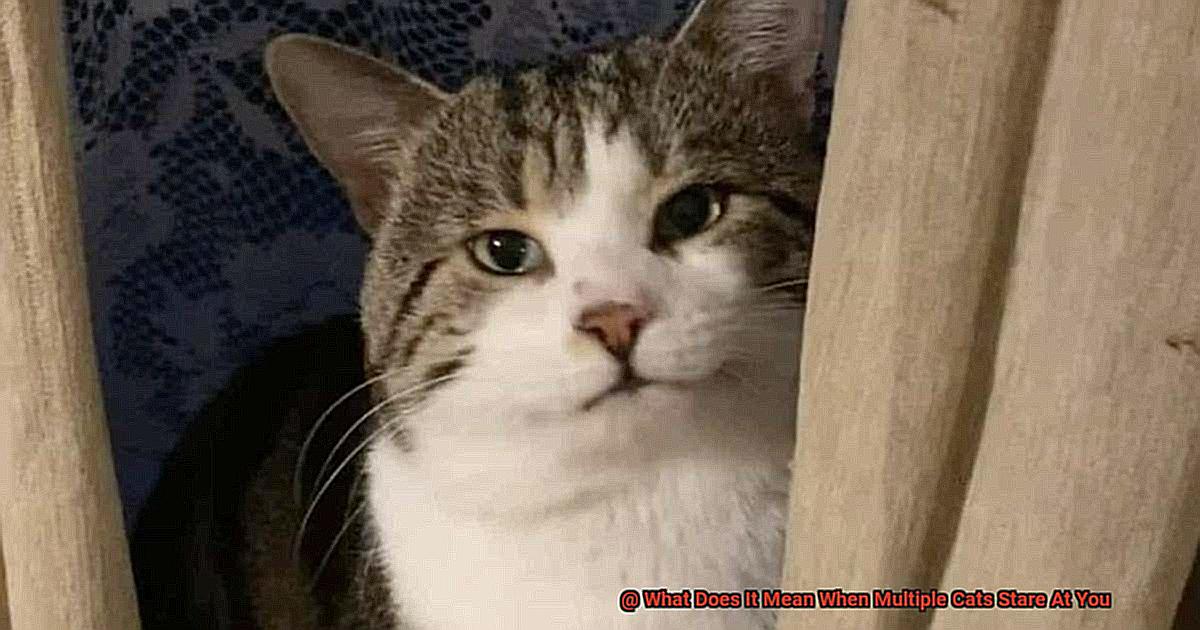Have you ever been minding your own business, only to look up and see a group of cats staring at you with their big, unblinking eyes? It can be cute, creepy, or downright unsettling. But what exactly does it mean when multiple cats stare at you?
Cats are known for their mysterious behavior, making it difficult to decipher their intentions. However, as cat lovers know, our feline friends have a unique way of communicating with us. Staring is just one example of this communication style. When several cats are staring at you, it could indicate a variety of things.
In this blog post, we’ll dive into the reasons why cats stare at humans and why it’s essential to pay attention to this behavior. We’ll also explore the different interpretations of multiple cat stares – is it a sign of affection or aggression? Are they trying to communicate something specific or just being curious?
So if you’re wondering what your furry companions are trying to tell you when they lock eyes with you, keep reading. You might discover a new perspective on your cat’s behavior that will deepen your bond with them.
Cats Are Naturally Curious
Cats are fascinating creatures that have captivated humans for centuries. They are known for their independent nature, mysterious behavior, and of course, their intense curiosity. This natural curiosity is an inherent aspect of a cat’s personality, and it is what makes them such wonderful pets.
When your cat stares at you, it is not because they are plotting against you, but rather because they are fascinated by you. Cats have excellent eyesight and can pick up on even the slightest movements or changes in their environment. If you are doing something interesting or unusual, your feline friend will be drawn to observe.
There are several reasons why cats are naturally curious:
Hunting Instincts
Cats have a strong instinct to hunt and explore, which is why they are always on the lookout for anything that moves or catches their attention. Whether it’s a toy mouse or a flickering light, your cat will be intrigued and want to investigate.
Intelligence
Cats are highly intelligent animals and need mental stimulation to keep their minds sharp. Exploring their surroundings is one way that they can exercise their brains and satisfy their curiosity.
Social Interaction
Cats are social animals and need interaction with other cats and humans to thrive. Staring at you may be your cat’s way of trying to engage with you and get your attention.
Establishing Dominance

Cats have a complex social structure, and establishing dominance is an important part of their behavior. If there are multiple cats in the room, they may be staring at each other to determine who is the alpha cat.
So, how can you encourage your cat’s natural curiosity? Here are some tips:
Provide toys
Toys are a great way to stimulate your cat’s curiosity and keep them entertained. Look for toys that encourage exploration and play, such as puzzle feeders or interactive toys.
Create a safe environment
Cats need a safe environment where they can explore without fear of harm or danger. Make sure your home is cat-proofed and provide plenty of hiding spots and elevated surfaces for your cat to climb on.
Spend quality time together
Cats thrive on social interaction, so spend quality time with your feline friend every day. Play games, cuddle, and talk to your cat to help them feel loved and engaged.
Establishing Dominance and Hierarchy
Cats are fascinating creatures with intricate social structures and communication methods. If you’re a cat owner with multiple feline friends, you may have witnessed them staring at each other or even at you. But did you know that this behavior is actually a way for cats to establish dominance and hierarchy within their group?
Staring is just one of the many ways cats assert their dominance over their peers. In a group of cats, the dominant cat will often stare at the other cats to show its superiority and establish its position. Similarly, if you have multiple cats in your household, you may notice them staring at each other to determine who is higher in the pecking order. You may also notice them staring at you to assert their dominance or to communicate their needs.
It’s essential to understand that this behavior is natural for cats and should not be interpreted as aggression or hostility. However, it’s crucial to pay attention to your cats’ body language when they’re staring at you or other cats. If the stare is accompanied by other signs of aggression, such as growling or hissing, it may be a warning sign of an impending fight.
As a responsible pet owner, it’s important to establish yourself as the alpha cat in your household. Here are some tips on how to do that:
- Set boundaries and rules: Just like humans, cats need rules and boundaries to coexist peacefully. Make sure your cats understand what behaviors are acceptable and what aren’t. Consistency is key here.
- Provide plenty of resources: Cats can be competitive when it comes to resources like food, water, litter boxes, and toys. Providing enough resources for all your cats can help reduce tension and promote harmony.
- Pay attention to body language: When your cats stare at each other or even at you, pay attention to their body language. If the stare is accompanied by other signs of aggression, such as growling or hissing, it could be a warning sign of an impending fight.
Cats Want Something From You
Cats are known to be independent creatures, but they also rely on their humans for food, shelter, and affection. When your cats stare at you, it’s their way of communicating that they want something from you.
Cats stare at their humans for different reasons, and it’s essential to understand their body language and behavior to determine what they need. The three common reasons why cats stare at their humans are:
Hunger
Cats have an excellent sense of smell and can sniff food from a distance. If you find your cats staring at you while you’re eating or preparing their meals, it’s a clear sign that they’re hungry and hoping for a snack. They may also meow or purr to get your attention and let you know that they are hungry.
Attention
Cats are social animals and love spending time with their humans. They may perch on your lap, rub against your legs, or purr loudly to show that they want love and attention. When your cats stare at you, it could be their way of asking for a snuggle session or some playtime with their favorite toys.
Curiosity
Cats are curious creatures by nature and enjoy observing their surroundings. If your cats are staring at you while you’re doing something, it could be because they’re intrigued and want to learn more about what’s going on.
Next time your cats stare at you, don’t freak out. Instead, try to understand what they want or need from you. If they’re hungry, give them some food or a treat. If they want attention, spend some quality time playing or cuddling with them. And if they’re just being curious, let them explore while ensuring their safety.
Cats Feel Threatened or Uncomfortable
It’s a common feeling, but one that can be quite unsettling. Don’t worry, though – as an expert on feline behavior, I’m here to help shed some light on why cats may feel threatened or uncomfortable in certain situations.
Firstly, it’s important to understand that cats are very territorial creatures. They like to have their own space and routine, and can become anxious if they perceive someone as intruding on their territory. This could happen even in your own home, with cats just passing through. If you find yourself in this situation, try to give the cats space and avoid making sudden movements or loud noises.
Another reason why cats may feel threatened or uncomfortable is because of their strong sense of self-preservation. If they feel like there is something or someone that poses a threat to them, they will go into defensive mode. This could include behaviors such as hissing, growling, or arching their backs to appear bigger and more intimidating. If you notice these behaviors from the cats, it’s best to back off and give them time to calm down.
One way to make cats feel more at ease is by recognizing their body language cues. Dilated pupils and flattened ears are clear signs that the cats are feeling scared or anxious. By understanding these cues and responding appropriately (such as by offering treats or toys), you can help build positive associations with your presence.
It’s also important to remember that cats communicate through body language, so your own body language can have an impact on how they perceive you. Avoid staring at them directly as this can be seen as a challenge. Instead, keep your gaze soft and indirect.
Observe the Cat’s Body Language
If you find yourself in the presence of multiple cats staring at you, it can be quite daunting. But with a keen eye for detail, you can decode their body language and communicate with them effectively.
Let’s start with their eyes. Dilated pupils can indicate that cats are feeling excited or stimulated, while constricted pupils may suggest relaxation or sleepiness. However, direct eye contact can be seen as a threat, so avoid staring them down.
The ears are also crucial indicators of how cats are feeling. If their ears are forward and alert, they’re likely interested in something or someone. Conversely, flattened ears against their head could indicate fear or aggression. Keep a close eye on their ears when approaching or interacting with them.
The position of a cat’s tail is another essential aspect of their body language. A raised tail typically means they’re feeling friendly and confident, while a lowered or tucked tail may signal fear or anxiety. Their tail can also give you an idea of whether they’re about to pounce or feeling relaxed.
Furthermore, pay attention to the overall posture of the cats. Are they crouched low to the ground, ready to pounce? Or are they standing tall and relaxed? These cues can provide important insights into how they’re feeling and what their intentions might be.
Understanding Feline Behavior
Feline behavior can be complex and hard to decode, especially when it comes to deciphering their body language. As an expert in understanding feline behavior, I’m here to reveal the secrets behind a cat’s stare and how to interpret their behavior.
Firstly, it’s important to understand that cats communicate primarily through body language. Their stares, movements, and actions all convey a message. As social creatures, cats use their body language to communicate with other cats and humans. Therefore, paying attention to their body language is crucial in understanding their behavior.
One significant aspect of feline behavior is territoriality. Domesticated cats have inherited some of the instincts of their solitary hunter ancestors. When multiple cats stare at their owner, they could be marking their territory or asserting dominance over the space. This behavior is more common in households with multiple cats as they establish a hierarchy and boundaries among themselves.
However, staring alone isn’t sufficient to determine a cat’s behavior. It’s important to consider other body language cues such as tail movement, ear position, and vocalizations. For instance, a cat with a stiff tail and dilated pupils may feel threatened or anxious, while a relaxed cat with a purring sound might just be seeking affection.
Another reason why multiple cats might engage in prolonged staring is to show affection or seek attention from their owners. Cats crave attention and interaction with humans just like dogs do. Therefore, a prolonged stare could mean that they want to play, cuddle, or be petted. In some cases, cats might stare to indicate that they are hungry or want a treat.
Building a Strong Bond With Your Cat
It’s not just about cuddles and playtime; understanding your cat’s behavior and preferences is key. Here are some tips to help you strengthen your bond with your cat.
Firstly, create a safe and secure environment for your cat. Make sure they have access to all their basic needs, like food, water, and clean litter boxes. Giving them comfortable places to sleep and play will also make them feel more at home. Spending quality time with your cat is also crucial. This includes playing with them, grooming them, and giving them affection.
Positive reinforcement is another effective way to build trust with your cat. Rewarding good behavior like using the litter box or scratching their scratching post instead of furniture will encourage them to continue these behaviors in the future. Consistency is key when using positive reinforcement.
Lastly, take the time to understand your cat’s unique personality and preferences. Some cats may be more social than others, while some may prefer solitude. By observing their behavior and spending quality time with them, you can better understand what they like and dislike.
Tips for Interacting With Multiple Cats
Interacting with multiple cats can be a rewarding but challenging experience. To ensure a harmonious environment, it’s important to keep a few key tips in mind. Here are five sub-sections that will help you interact with multiple cats effectively.
Provide Enough Resources
The first and most important tip is to provide enough resources for all cats. This means having multiple litter boxes, food bowls, and water dishes available throughout the home. Cats are territorial creatures, so having enough resources can reduce competition and aggressive behavior. Make sure that each cat has their own designated areas to eat, drink, and use the litter box to avoid conflicts.
Establish a Routine
Cats thrive on routine, so it’s important to establish a regular schedule for feeding, playtime, and cuddles. This can help your cats feel more secure and reduce any anxiety they may have about sharing their space with other feline friends. Consistency is key when it comes to establishing a routine. Try to stick to a similar schedule every day, even on weekends.
Provide Vertical Space
Cats love to climb and perch on high surfaces. Providing vertical space such as cat trees or shelves can give your cats a place to retreat if they feel overwhelmed or stressed. This can also reduce competition for space on the ground level. Cats also enjoy looking out windows, so consider placing a cat tree near a window for an added bonus.
Introduce New Cats Gradually
If you’re introducing a new cat to your household, it’s important to do so gradually and under supervision. Introduce the cats slowly by keeping them in separate rooms with their own resources at first. Once they are comfortable with each other’s scents, you can start supervised visits where they can interact under your watchful eye. Don’t rush the introduction process, as it can take several weeks or even months for cats to adjust to each other.
Respect Each Cat’s Personality
Each cat has their own unique personality and preferences. Some cats may prefer more alone time while others may enjoy cuddling with their feline friends. It’s important to recognize and respect each cat’s individual personality and preferences. By understanding each cat’s preferences, you can create an environment where all cats feel comfortable and happy. Make sure to give each cat individual attention and affection on a regular basis.
Conclusion
In conclusion, the enigmatic behavior of cats is no secret, and staring is just one way they communicate. When multiple cats stare at you, it can indicate a variety of things. They could be exercising their natural curiosity, attempting to establish dominance or hierarchy, seeking attention or affection, or feeling threatened or uncomfortable.
To encourage your cat’s innate curiosity, provide toys that stimulate exploration and playtime. Create a secure environment with hiding spots and elevated surfaces for climbing to promote safety while satisfying your cat’s desire for adventure. Spending quality time together every day will also help strengthen your bond.
When interacting with multiple cats, it’s critical to provide enough resources for all feline family members. Establishing a routine and providing vertical space will ensure that each cat has its own territory. Introducing new cats gradually under supervision is also essential when integrating new members into an existing group.
Remember that cats communicate primarily through body language. Paying attention to their eyes, ears, tail movement, and posture can help you understand their behavior better.







